|
Discover a Bit of Columbus in
Pennsylvania
by Bob Brooke
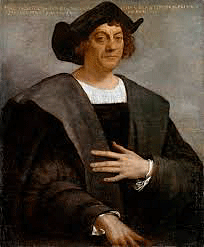 The
State of Pennsylvania seems like the least likely spot where you’d find
memorabilia from Christopher Columbus, the Italian sea captain who has
long been believed as the man who discovered the New World. While new
findings dispute that claim, Columbus nevertheless did foster further
exploration of the Americas which led to the many cultures present in
them today. The
State of Pennsylvania seems like the least likely spot where you’d find
memorabilia from Christopher Columbus, the Italian sea captain who has
long been believed as the man who discovered the New World. While new
findings dispute that claim, Columbus nevertheless did foster further
exploration of the Americas which led to the many cultures present in
them today.
But what does Columbus have to do with Pennsylvania? Believe it or not,
not much, except that tucked away in the little town of Boalsburg,
nearly hidden by a large cemetery, is the Boal family estate. Here in a
small stone building lie the contents of Columbus’ personal chapel,
brought all the way from Spain in 1909 by Theodore “Terry” Davis Boal,
the great grandson of David Boal, the first resident of the property.
The Boal estate has been the Boal family home for over 200 years and
tells the story of America as seen through one family. The original
buildings, furnishings, and family belongings are all still there.
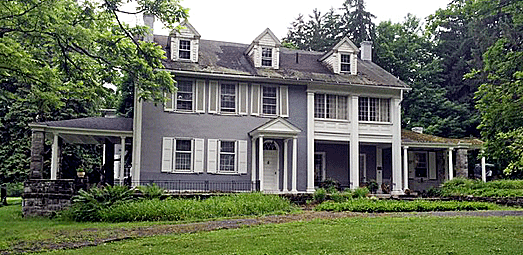
The only way to see the interior of the mansion and chapel is on a tour
which includes the first floor of the Boal Mansion, as well as the
Columbus Chapel. There are also three exhibit rooms filled with
centuries-old weapons and a stage coach from 1850.
The Boal Mansion
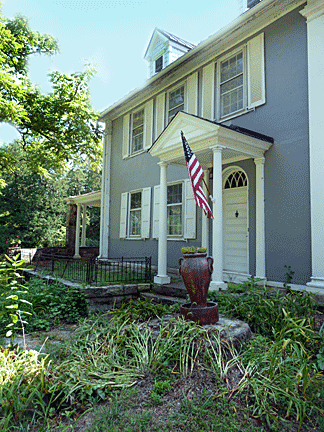 The
Mansion is in need of repair. The grass and weeds grow high around the
entrance to the porch. But the elegant Georgian lines of the home’s
exterior show its age. All is quiet now, for the last Boal family member
has died, leaving the mansion to tell the story of this once prominent
family. The
Mansion is in need of repair. The grass and weeds grow high around the
entrance to the porch. But the elegant Georgian lines of the home’s
exterior show its age. All is quiet now, for the last Boal family member
has died, leaving the mansion to tell the story of this once prominent
family.
It’s a warm September afternoon. The sunlight creates a dappled effect
on the lawns as it filters through the trees. The house is a sprawling
affair, built like topsy over the years. It’s pale blue and white
exterior standing out from the surrounding landscape. To the casual
onlooker, it appears abandoned, but inside are where the treasures lie.
David Boal, the property's original resident, build a simple
one-and-a-half story stone cabin in 1809. A short time later, it became
the kitchen and adjoining hall in the larger two-story, stone house
built in the Georgian style. A later generation of the Boal family
expanded the house again, adding two additional bays to the facade
between 1898 and 1905, and introduced some Beaux-Arts details to it.
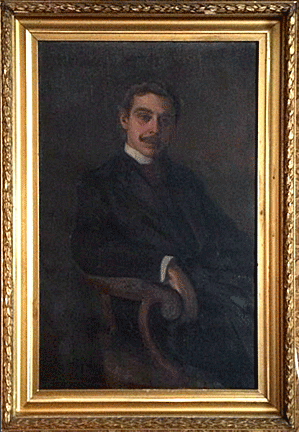 But
it was Theodore Davis Boal, David Boal’s great grandson who did the most
to cerate the house you see today and acquired many of the treasures
within it. But
it was Theodore Davis Boal, David Boal’s great grandson who did the most
to cerate the house you see today and acquired many of the treasures
within it.
After entering through the porch door, you’ll be taken through the
ballroom to the entrance hall. A ram’s head hatrack holds riding gear,
perhaps once used by a family member when hunting foxes. More family
portraits line the white spindled stairway leading to the second floor,
currently closed to visitors. Wallpaper from the 1860s with a large
architectural print lines the walls of this hallway. A large blanket
chest stands below an equally large mirror dating from the early 19th
century.
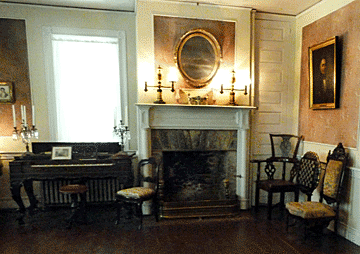 The
front parlor, with its fireplace by a window, is small and cozy. An
unusual corner chair from about the 1820s occupies the corner next to
the fireplace. The piano under the window spent 100 years in the White
House, having been bought by Dolly Madison after the White House was
burned in the War of 1812. The Boals purchased it at a White House
auction. A card table and chess/checker table show that the family used
this room for relaxation and not so much for formal entertaining. An
upright piano from the 1840s sits in the opposite corner from the
fireplace. The
front parlor, with its fireplace by a window, is small and cozy. An
unusual corner chair from about the 1820s occupies the corner next to
the fireplace. The piano under the window spent 100 years in the White
House, having been bought by Dolly Madison after the White House was
burned in the War of 1812. The Boals purchased it at a White House
auction. A card table and chess/checker table show that the family used
this room for relaxation and not so much for formal entertaining. An
upright piano from the 1840s sits in the opposite corner from the
fireplace.
 Through
an adjacent doorway, you enter the library, a room about the same size
as the living room, containing an assortment of chairs from different
periods and a Victorian Empire sofa from the 1840s as well as its share
of portraits. The focal point of the room is a large fireplace, on the
mantel of which sit signed photographs of John F. Kennedy and Franklin
Delano Roosevelt. A small table holds a photo signed by all three of the
Apollo 11 astronauts after their successful moon landing. Through
an adjacent doorway, you enter the library, a room about the same size
as the living room, containing an assortment of chairs from different
periods and a Victorian Empire sofa from the 1840s as well as its share
of portraits. The focal point of the room is a large fireplace, on the
mantel of which sit signed photographs of John F. Kennedy and Franklin
Delano Roosevelt. A small table holds a photo signed by all three of the
Apollo 11 astronauts after their successful moon landing.
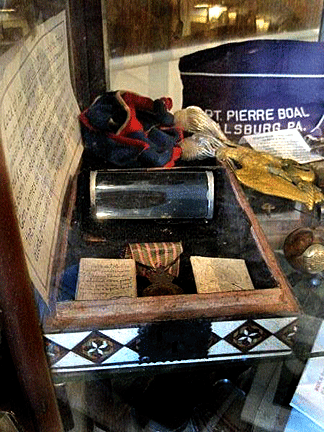 Numerous
family keepsakes dot the smaller tables in the room. One of the more
unique objects is a Roman soldier’s helmet with its horsetail attached.
On the other side of the room on a table filled with books is a French
clock from the 1880s, one of several clocks in the room, none of which
belonged to the Boal family. A bronze inkwell with a figure of a horse
and rider sits on a small drop-front desk. A special display case
contains the Boal family’s most prized memorabilia, including a lock of
Napolean Bonaparte’s hair—he was related to the Boal family—as well as
items from the graves of King Tut’s grandparents—a Boal relative
financed Howard Carter’s first expedition in Egypt. Numerous
family keepsakes dot the smaller tables in the room. One of the more
unique objects is a Roman soldier’s helmet with its horsetail attached.
On the other side of the room on a table filled with books is a French
clock from the 1880s, one of several clocks in the room, none of which
belonged to the Boal family. A bronze inkwell with a figure of a horse
and rider sits on a small drop-front desk. A special display case
contains the Boal family’s most prized memorabilia, including a lock of
Napolean Bonaparte’s hair—he was related to the Boal family—as well as
items from the graves of King Tut’s grandparents—a Boal relative
financed Howard Carter’s first expedition in Egypt.
Walking through another doorway takes you into the spacious dining room
with its extra large cooking fireplace.
This would have probably been the kitchen in the original cabin. As
assortment of Bohemian cut glass decanters decorate the mantel. 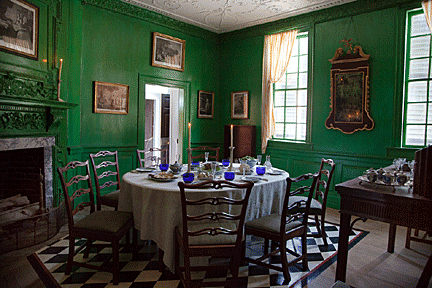 A large
Colonial Revival dining table and chairs in the Hepplewhite style most
likely date from the last decade of the 19th century. Complementing it
is a sideboard of the same vintage which features two pull-out shelves
that would have held candlesticks during dinner. A large
Colonial Revival dining table and chairs in the Hepplewhite style most
likely date from the last decade of the 19th century. Complementing it
is a sideboard of the same vintage which features two pull-out shelves
that would have held candlesticks during dinner.
Next is the ballroom, added to the mansion in 1898 by Terry Davis Boal.
This large room reflects the opulence that wealthy Americans strived for
at the end of the 19th century.
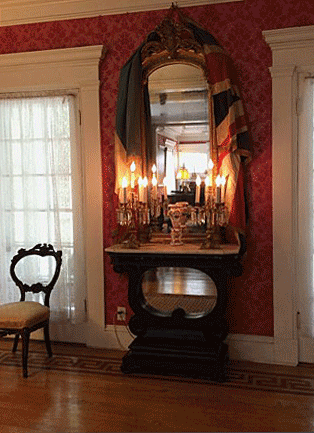 A
large gold-leafed mirror, draped in the both French and British flags,
dominates the far end of the room and hints at the family’s heritage. A
grand piano, standing next to a large white fireplace with an ornate
French Regency clock on its mantel, highlights the vast room, with its
gold brocade upholstered Rococo Revival chairs and sofas lining its
perimeter. The soft sheen of the inlaid hardwood floors reflect the
sunlight coming in through the large windows. A harpsicord stands
against the wall and crystal chandeliers provide overhead light. A large
brass Turkish heater sits in front of the fireplace. A
large gold-leafed mirror, draped in the both French and British flags,
dominates the far end of the room and hints at the family’s heritage. A
grand piano, standing next to a large white fireplace with an ornate
French Regency clock on its mantel, highlights the vast room, with its
gold brocade upholstered Rococo Revival chairs and sofas lining its
perimeter. The soft sheen of the inlaid hardwood floors reflect the
sunlight coming in through the large windows. A harpsicord stands
against the wall and crystal chandeliers provide overhead light. A large
brass Turkish heater sits in front of the fireplace.
Portraits of family members hang on the red flocked wallpapered walls. A
magnificent French Rococo mirror hangs between two sofas on the interior
side wall. A crystal chandelier’s light reflects its glow in the mirror.
There’s a staid elegance here.
After leaving the ballroom, you’re once again outdoors where you can see
the small bell tower on the roof of the original cabin, now located in
the middle of the sprawling home.
The Columbus Chapel
From the mansion, the building housing Columbus’s personal chapel seems
like a gray stone box standing in the trees. This is the highlight of a
visit here.
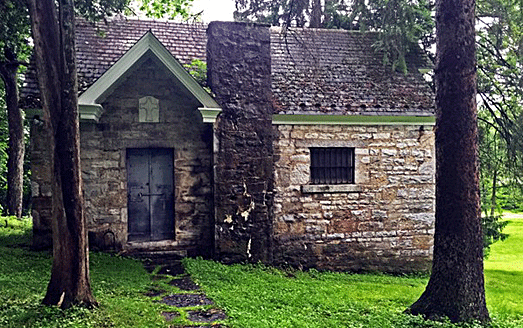
Trained as an architect, Terry Boal designed several buildings in
Denver, Colorado, before traveling to Paris, France, to continue his
studies. While there, he married Mathilde Dolorès Denis de Lagarde, a
French aristocrat related to Christopher Columbus. When his wife’s aunt
died, the Boal family inherited the Columbus family castle in Asturias,
Spain. Boal built an exact replica of the castle’s chapel and had the
entire contents boxed up and shipped to Boalsburg in 1909.
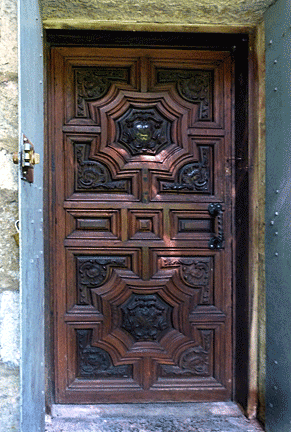 The
original wooden door of the chapel is inset behind a protective grate.
Once inside, the striking beauty of the pieces is evident. While they
may have been installed in their original places, the vaulted interior
of the chapel building, painted a moss green, is plain and the floor
cement. In its original location, the chapel would have had a mosaic
tile or stone floor, completing the beauty of the objects. The
original wooden door of the chapel is inset behind a protective grate.
Once inside, the striking beauty of the pieces is evident. While they
may have been installed in their original places, the vaulted interior
of the chapel building, painted a moss green, is plain and the floor
cement. In its original location, the chapel would have had a mosaic
tile or stone floor, completing the beauty of the objects.
Items range from beautiful 15th century paintings to large religious
statues. The Columbus family tree, including illegitimate branches
denoted in brown, hangs on the far wall. The Columbus family coat of
arms dating back to the 15th century hangs from the railing of the choir
loft at the rear. The chapel also contains Columbus’ own folding desk.
The Boal family converted the chapel’s confessionals into storage for
nearly 500 years of family correspondence. Tens of thousands of pages of
perfectly preserved documents sit on the cabinet’s walls.
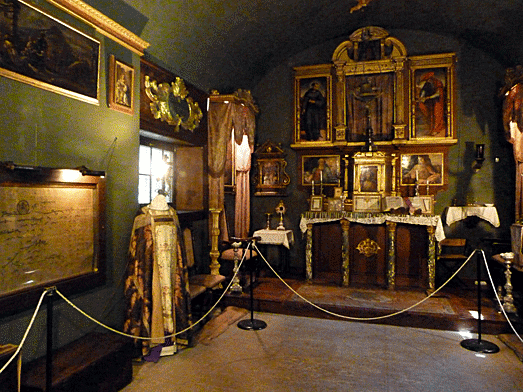
The main altarpiece features paintings of saints and four green faux
marble painted columns. Chairs for the priest and attendants, displays
of vestments, and a cabinet with wide drawers holding vestments for
special religious celebrations complete the collection.
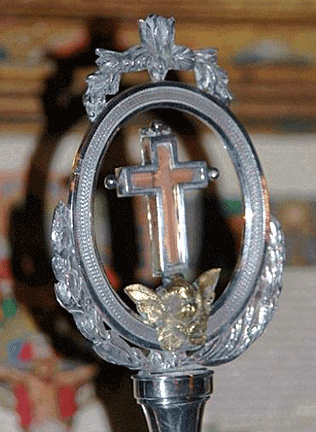 However,
a small silver cross atop the altar might be the most amazing piece in
the entire chapel. If you look closely, you’ll notice two small pieces
of wood inside. According to manuscript on the wall certified by a
Spanish bishop, these wooden pieces are from the “True Cross of Jesus”
and were brought back during the Crusades. However,
a small silver cross atop the altar might be the most amazing piece in
the entire chapel. If you look closely, you’ll notice two small pieces
of wood inside. According to manuscript on the wall certified by a
Spanish bishop, these wooden pieces are from the “True Cross of Jesus”
and were brought back during the Crusades.
There’s a lot of history packed into this relatively small property.
Upon careful inspection, it goes well beyond Columbus and his voyages.
Hours: Tuesday through Sunday: 1:30 to 5 P.M.
Open: May 1 through October 31
Admission: Adults: $10, Children: $6
Visit the Boal
Museum Web site.
More photos of the Boal Museum
and Columbus Chapel.
<
More Special Features
Next Article > |
